Threatened and EPBC Act
priority species
Five-Year Outcome: By 2023, the trajectory of species targeted under the Threatened Species Strategy and other EPBC Act priority species is stabilised or improved
Investment Priorities:
- Ant Plant (Myrmecodia beccarii)
- Eastern Curlew (Numenius madagascariensis)
- Southern Cassowary (Casuarius casuarius johnsonii)
- Greater Bilby (Macrotis lagotis)
- Mahogany Glider (Petaurus gracilis)
Background Information:
The Burdekin Dry Tropics region is home to a number of threatened species:
- 7 Critically Endangered species (1 mammal, 3 bird, 1 reptile, 1 amphibian and 1 fish species);
- 23 Endangered species (7 mammal, 7 bird, 4 reptile, 1 amphibian and 4 land plant species);
- 47 Vulnerable species (10 mammal, 9 bird, 7 reptile, 2 amphibian, 1 fish and 18 land plant species).
Twenty species have Recovery Plans and 33 have Conservation Advice.
Current Projects:
There are currently no projects being undertaken for this outcome or these investment priorities in the Burdekin Dry Tropics region, as the majority of the critical habitat for these species occurs outside the region.
Alignment with Sub-regional aspirations and regional goals:
This outcome aligns with the regional goal in the NRM Plan:
- The unique biodiversity of the Burdekin Dry Tropics region is protected and enhanced to increase the resilience of native species, ecosystems and ecological processes (page 67).
The right to protect Country and culture is fundamental to Traditional Owners as the custodians of Country based on a history of more than 60,000 years. Traditional Owners aspire to have greater management, involvement and empowerment over Country and their cultural knowledge and understanding of Country are embraced. The Traditional Owner aspirations for the region can be found in the Burdekin Dry Tropics NRM Plan (pages 25-26), Caring for Country Plan (2005) and the Indigenous Participation Plan. Access to Country to connect and manage cultural and natural resources continue to be priorities for Traditional Owners. A map of Traditional Owner group areas can be accessed here.
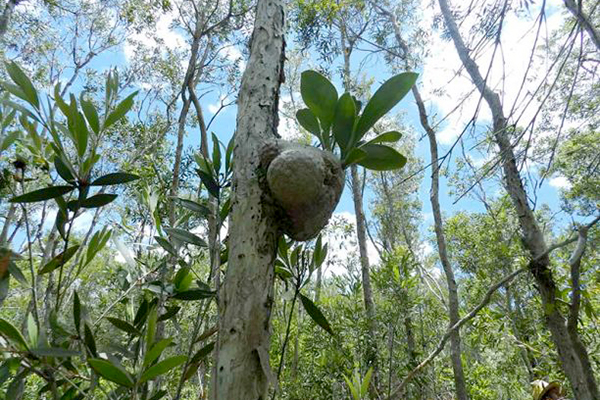 Ant Plant
Ant Plant
Status:
Vulnerable – Nature Conservation (Plants) Regulation 2020 (Queensland)
Vulnerable – Environment Protection and Biodiversity Conservation Act 1999 (EPBC Act).
Conservation Advice:
Approved Conservation Advice (2008)
Recovery Plan:
There is no adopted or made Recovery Plan for this species
Threat Abatement Plan:
There is no Threat Abatement Plan identified as relevant for this species
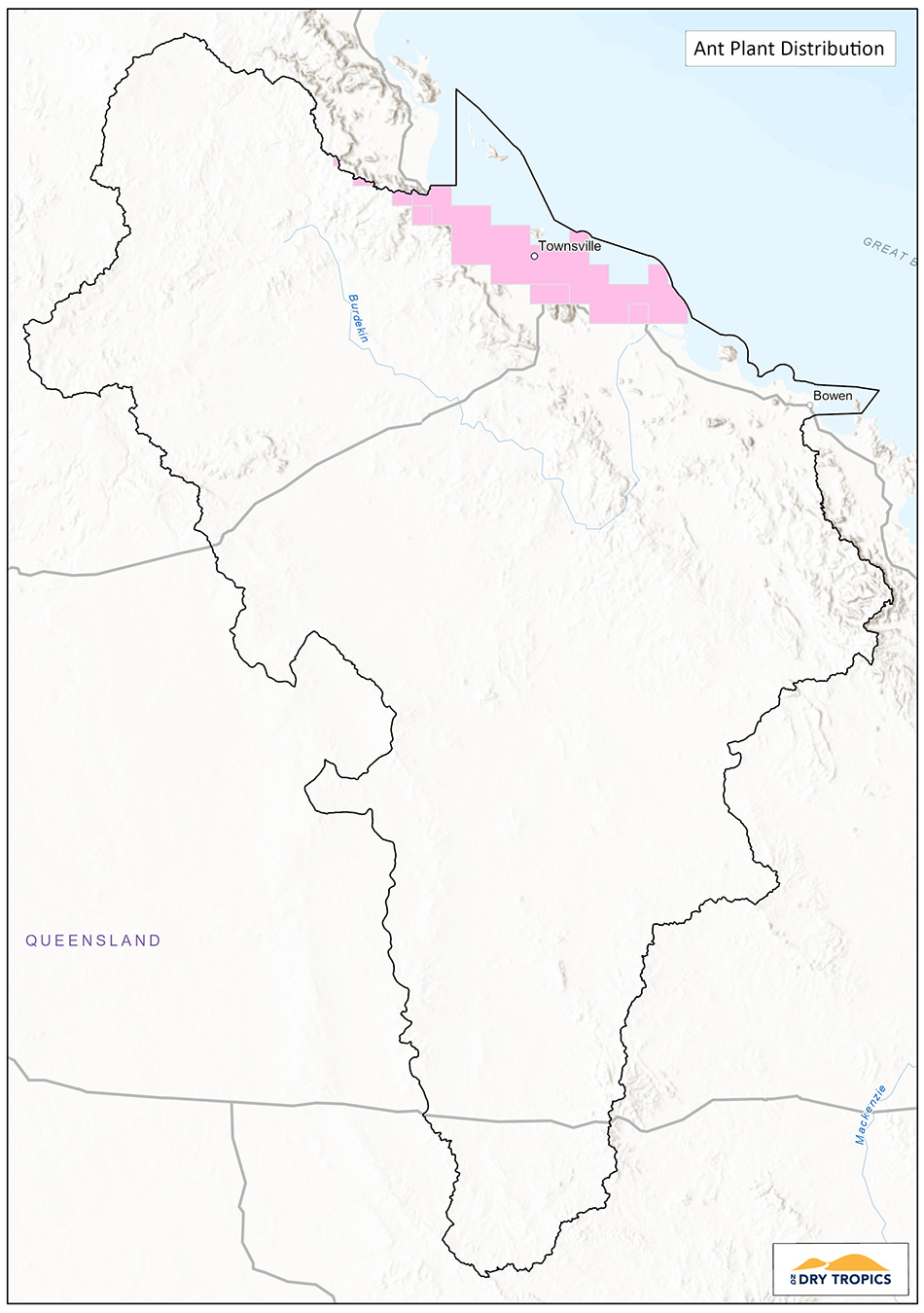 Background Information:
Background Information:
The Ant Plant (Myrmecodia beccarii) is a tuberous epiphyte (a plant growing on other plants without harming them) found in the wet tropics of Queensland. It is known to occur in open coastal woodlands dominated by melaleuca or mangroves, between Cooktown and Ingham.
The species is conserved within the Girringun National Park (NP), Daintree NP and Edmund Kennedy NP.
The majority of the range of this species occurs in the Wet Tropics, however a small section of Girringun National Park is in the northern-most area of the Burdekin Dry Tropics region.
This species has a unique association with the Golden Ant (Iridiomyrmex cordatus) which lives in the chambers of the tuber and the Apollo Jewel butterfly (Hypochrysops apollo apollo) which lays its eggs on the plant. The golden ants carry the butterfly eggs into the chambers where they develop into butterflies.
The main threats to this species are habitat loss, invasive weeds, removal of plants by plant and butterfly collectors.
Priority actions identified to assist this species are:
- Protect, maintain and expand habitat through weed control, revegetation and fencing
- Raise awareness about impacts of illegal collecting
- Grow horticulturally
This species occurs primarily in areas managed by the Wet Tropics Management Authority, Queensland National Parks and Wildlife Service (Department of Environment and Science) and the Wet Tropics (Terrain) and Cape York NRM regions.
Key Collaborators
This list does not cover all groups or organisations, but rather represents the ‘key’ organisations and groups whose assistance, advice, approval or cooperation would be required to work on Ant Plant in the Burdekin Dry Tropics region.
- Department of Agriculture, Water and Environment (DAWE)
- Queensland Department of Environment and Science (DES)
- Queensland Parks and Wildlife Service (QPWS)
- Nywaigi anbd Wulgurukaba Traditional Owners and Girringun Reference Group
- NQ Dry Tropics (regional NRM group)
- Terrain NRM (regional NRM group)
- Wet Tropics Management Authority (Division of DES)
Monitoring:
There are currently no monitoring programs with publicly available information being undertaken. The Conservation Advice for the species specifies the requirement to establish monitoring programs and support any currently underway, both at a local and regional level.
Potential indicators for the Ant Plant:
- presence and abundance;
- distribution; and
- presence/abundance of Golden Ants and Apollo Jewel Butterflies.
Links and further information:
- Burdekin Dry Tropics Conservation Action Planning Summary Report.
- Department of Agriculture, Water and Environment: Ant Plant.
- Approved Conservation Advice.
- Species Profile and Threat Database (SPRAT) profile.
- QLD National Parks and Wildlife Service
- Terrain NRM
- Cape York NRM
- Wet Tropics Management Authority
- QLD Herbarium
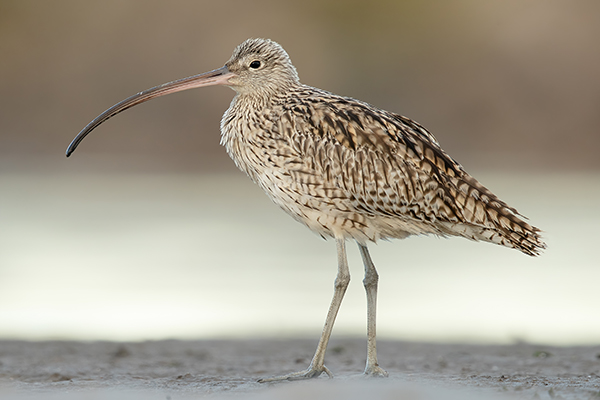 Eastern Curlew
Eastern Curlew
Status:
Endangered – Nature Conservation (Animals) Regulation 2020 (Queensland).
Critically Endangered – Environment Protection and Biodiversity Conservation Act 1999 (EPBC Act).
Endangered – IUCN Red List.
Conservation Advice:
Approved Conservation Advice (2015).
Recovery Plan:
There is no adopted or made Recovery Plan for this species (the approved conservation advice for the species provides sufficient direction to implement priority actions and mitigate against key threats).
Threat Abatement Plan:
There is no Threat Abatement Plan identified as relevant for this species.
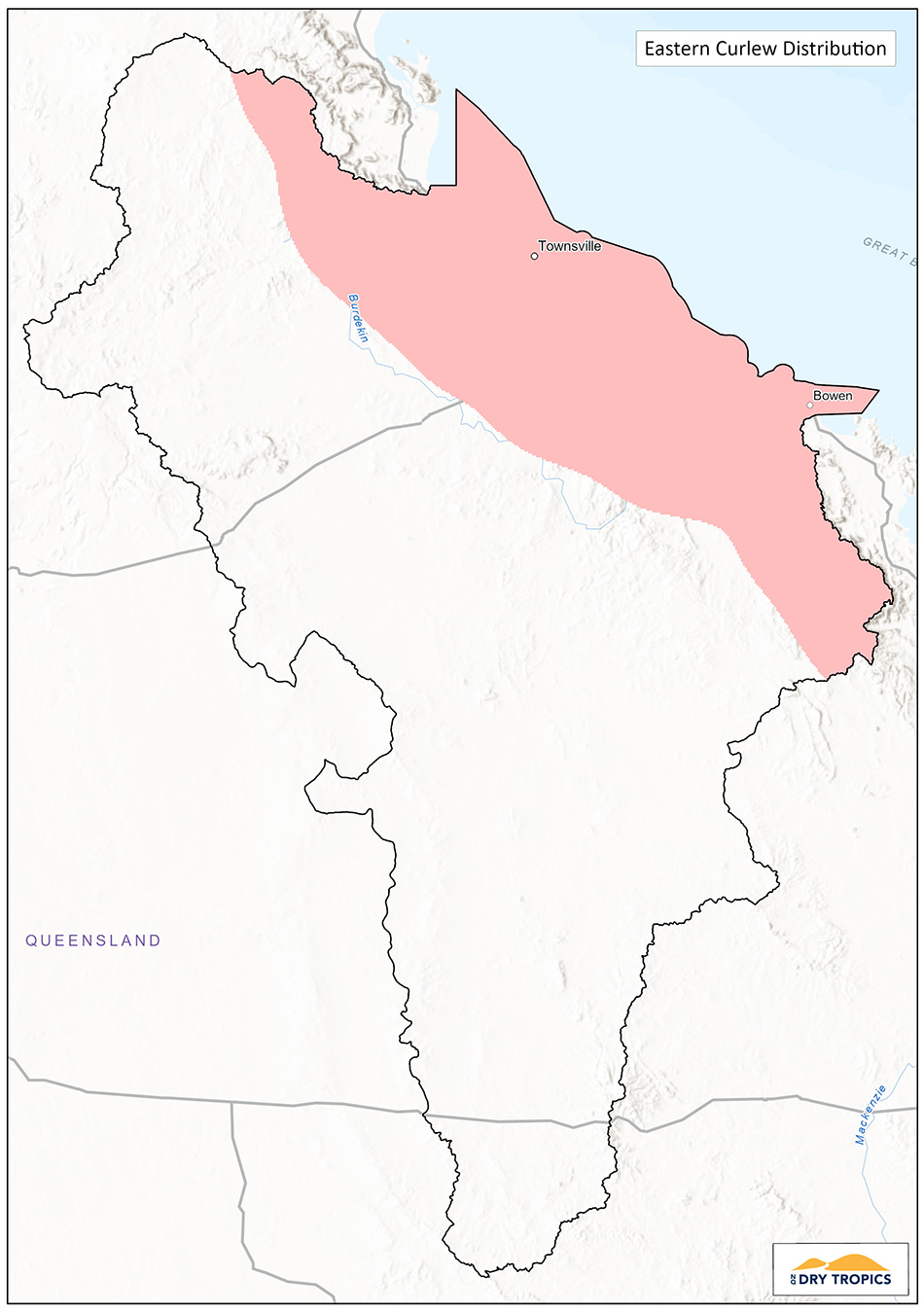 Background Information:
Background Information:
The Eastern Curlew (Numenius madagascariensis) is a migratory shorebird species. It is the largest shorebird in the world and undertakes an annual migration between the northern and southern hemispheres. The breeding grounds of the Eastern Curlew are in north-eastern Asia including Siberia, Russia and Mongolia, while the wintering grounds are primarily in coastal Australia, with lower numbers wintering in south-east Asia (South Korea, Thailand and the Philippines), Papua New Guinea and New Zealand. The intertidal mud flats of the Yellow Sea are a critical habitat that are used during migration as a stop-over and staging sites.
In the southern hemisphere (non-breeding season) it is typically found in coastal areas such as seagrass beds, mangrove swamps, saltmarshes, tidal flats and beaches. In these areas they use their long, curved beak to probe the substrate to feed on marine invertebrates such as molluscs, crustaceans and worms.
In Australia, it has been recorded in coastal areas in all states, however south-eastern Queensland has the highest concentration of numbers around Moreton Bay and Sandy Straight. In the Burdekin Dry Tropics region, sighting have been made at Bowling Green Bay and in coastal areas north of this.
This species is listed in bilateral migratory bird agreements; Bonn Convention on the conservation of migratory species, CAMBA (China), JAMBA (Japan) and ROKAMBA (Republic of Korea).
As a migratory bird that ranges over a large geographical distance and relies on habitat along the migratory path in order to successfully undertake the migratory journey, there are a wide range of threats to this species including habitat destruction and disruption due to coastal development affecting breeding and feeding opportunities, hunting and predation, being by-catch in fishing nets and the impacts of climate change and pollution.
In Australia, the primary threats are loss of and disruption to coastal habitats used for foraging and roosting. This is due to coastal development and use of coastal areas, such as walking dogs off leash. In the Burdekin Dry Tropics region the habitat used by the Eastern Curlew occurs along the coastline, including areas within Great Barrier Reef Marine Park.
At an international level, work to address the threat to the species is concentrated on maintaining and implementing the bilateral agreements to protect and restore breeding and migration stop-over sites. In Australia, management actions are concentrated on the maintenance and protection of roosting and feeding sites, incorporation of the requirements for the species in coastal planning and management and managing disturbance at important sites. Within the Burdekin Dry Tropics, the shorebird vulnerability assessment undertaken by the Great Barrier Reef Marine Park authority lists 14 specific actions to address vulnerabilities for shorebird species, including further research and monitoring, protection of areas outside existing conservation reserves, managing threats such as pest species, marine debris and human disturbance and working with other states and countries to protect migration flyways.
This species occurs in areas managed by the Great Barrier Reef Marine Park Authority, the QLD National Parks and Wildlife Service, local councils and private owners.
Key Collaborators:
This list does not cover all groups or organisations, but rather represents the ‘key’ organisations and groups whose assistance, advice, approval or cooperation would be required to work on the Eastern Curlew in the Burdekin Dry Tropics region.
- Department of Agriculture, Water and Environment (DAWE)
- Queensland Department of Environment and Science (DES)
- Queensland Parks and Wildlife Service (QPWS)
- Nywaigi, Manbarra, Wulgurukaba and Bindal Traditional Owners, Girringun Reference Group and Gudjuda Reference Group
- Great Barrier Reef Marine Park Authority
- Townsville City Council
- Burdekin Shire Council
- Whitsunday Regional Council
- Queensland Wader Study Group
- NQ Dry Tropics (regional NRM group)
Monitoring:
Threatened Species Recovery Hub project and monitoring – https://www.nespthreatenedspecies.edu.au/projects/strategic-planning-for-the-far-eastern-curlew https://www.nespthreatenedspecies.edu.au/news-and-media/latest-news/curlew-globe-trotting-update
- Queensland Wader Study Group satellite tracking 2017-2018 https://waders.org.au/studying-waders/banding-shorebirds/satellite-transmitters-and-geolocators/far-eastern-curlew-and-whimbrel-satellite-tracking-2017-2018/
- Atlas of Living Australia – Sightings and data sets – https://bie.ala.org.au/species/urn:lsid:biodiversity.org.au:afd.taxon:21ab21e4-5cd7-4e68-9268-1b6db1a9c3aa#overview
- Department of Agriculture, Water and Environment – Eastern Curlew Scorecard 2018 http://environment.gov.au/biodiversity/threatened/species/20-birds-by-2020/eastern-curlew
- Eastern Australia Waterbird Survey – https://www.ecosystem.unsw.edu.au/research-projects/rivers-and-wetlands/waterbirds/eastern-australian-waterbird-survey
Potential indicators for the Eastern Curlew:
- Presence / abundance at coastal wintering sites
- Banding and capture / recapture data
- Availability and condition of suitable habitat
Links and further information:
- Burdekin Dry Tropics Conservation Action Planning Summary Report.
- Department of Agriculture, Water and Environment: Eastern Curlew – https://www.environment.gov.au/biodiversity/threatened/species/20-birds-by-2020/eastern-curlew
- Approved conservation advice – http://www.environment.gov.au/biodiversity/threatened/species/pubs/847-conservation-advice.pdf
- Great Barrier Reef Marine Park Authority
- GBRPMA – Shore vulnerability assessment and Seabirds and shorebirds in the Great Barrier Reef World Heritage Area in a changing climate https://www.gbrmpa.gov.au/__data/assets/pdf_file/0019/21745/gbrmpa-VA-Shorebirds-11-7-12.pdf https://www.gbrmpa.gov.au/__data/assets/pdf_file/0006/4101/sea-birds-and-shore-birds-2008.pdf
- Queensland Wader Study Group – https://waders.org.au/
- Birds Australia Species Conservation Summary – https://eaaflyway.net/wp-content/uploads/2017/12/Eastern-Curlew.pdf
- International single species action plan for the conservation of the far eastern curlew – https://www.cms.int/sites/default/files/document/cms_cop12_doc.24.1.7_eastern-curlew-ssap_e.pdf
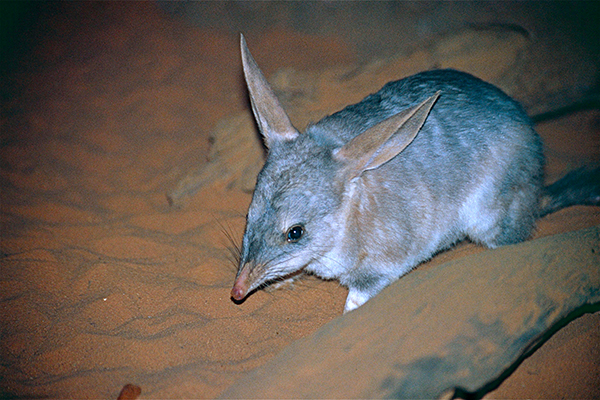 Greater Bilby
Greater Bilby
Status:
Endangered – Nature Conservation (Animals) Regulation 2020 (Queensland).
Vulnerable – Environment Protection and Biodiversity Conservation Act 1999 (EPBC Act).
Vulnerable – IUCN Red List.
Conservation Advice:
Approved Conservation Advice (2016)
Recovery Plan:
There is a National Recovery Plan for this species.
Threat Abatement Plan:
There are three Threat Abatement Plans for this species (Feral cats, foxes and rabbits).
 Background Information:
Background Information:
The Greater Bilby (Macrotis lagotis) (hereafter referred to as ‘bilby’) is one of two species of bilby that occurred in Australia, with the Lesser Bilby (Macrotis leucura) declared extinct.
The bilby is a ground-dwelling, burrowing marsupial that is most closely related to bandicoots and is roughly the size of a rabbit. It is nocturnal, coming out of the burrow at night to feed. It is omnivorous, eating insects such as termites, seeds, fungi, bulbs and fruit. They do not require free water to drink, as they are adapted to arid environments and are able to extract sufficient moisture from their food. Bilbies can live to around seven years of age and are capable of reproducing quickly in favourable conditions, with females able to produce up to eight young per year. As with other marsupials, the female gives birth to undeveloped young who complete their development in the pouch.
Prior to European settlement, the bilby was widespread in Australia, found in arid through to temperate coastal areas, however primarily due to the impacts of habitat loss and introduced animals their range has contracted severely to primarily arid and semi-arid regions and restricted areas in which populations remain.
In Queensland, their distribution, which once covered most of the state south of the Wet Tropics, has been reduced to remnant populations in the south west of the state, with the largest remaining population in an area west of the Diamantina River, in Astrebla Downs National Park, Diamantina National Park and some pastoral properties. In 2019 the greater bilby was reintroduced to a 2,500 hectare predator-free enclosure on Currawinya National Park near the Queensland-New South Wales border.
There are no known current populations in the Burdekin Dry Tropics Region.
The decline in this species has occurred due to habitat disturbance brought about primarily through grazing and from competition with and predation by introduced species. The change in habitat brought through large grazing animals (sheep and cattle), changed fire regimes and the installation of watering points have impacted on the viability of bilby populations. However, at this time the largest threat is from introduced predators, the feral cat and fox, which prey heavily on bilbies.
Management is primarily undertaken by the Department of Environment and Science and Queensland National Parks and Wildlife Service (where Bilby populations are within National Park boundaries). The actions required to prevent further losses and increase populations are provided in the National Threatened Species Recovery Plan for the species:
- Reduce impact of predation by introduced carnivores.
- Maintain genetic diversity through captive breeding program.
- Establish self-sustaining populations within former range.
- Monitor trends in occurrence and abundance.
- Assess the impact of predators, fire and other threatening processes on bilby populations.
- To inform and involve the community and all stakeholders in the recovery process.
- Continue to manage the recovery process through a national recovery team.
Key Collaborators
This list does not cover all groups or organisations, but rather represents the ‘key’ organisations and groups whose assistance, advice, approval or cooperation would be required to work on the Greater Bilby in Queensland.
- Department of Agriculture, Water and Environment (DAWE)
- Queensland Department of Environment and Science (DES)
- Queensland Parks and Wildlife Service (QPWS)
- National Bilby Recovery Team
- Save the Bilby Fund
- Traditional Owner groups
Monitoring:
Monitoring on properties that are owned and / or managed by Not for Profit organisations such as the Australian Wildlife Conservancy are conducted by the relevant organisation. Likewise, any populations within National Parks are monitored by the Queensland National Parks and Wildlife Service (QPWS). Other monitoring programs and sources of data are available through the below links:
- Atlas of Living Australia – https://bie.ala.org.au/species/urn:lsid:biodiversity.org.au:afd.taxon:3814d122-c95f-467f-a3a2-2b269931b74f
- Threatened Species Recovery Hub – https://www.nespthreatenedspecies.edu.au/
Potential indicators for bilbies include:
- Presence and abundance
- Availability and use of suitable habitat
- Rates and causes of mortality
- Fecundity
Links and further information:
- Burdekin Dry Tropics Conservation Action Planning Summary Report.
- Department of Environment and Science
- National Threatened Species Recovery Plan – Greater Bilby.
- Greater bilby recovery summit 2015: report and interim conservation plan.
- Save the Bilby Fund.
- Threatened Species Recovery Hub.
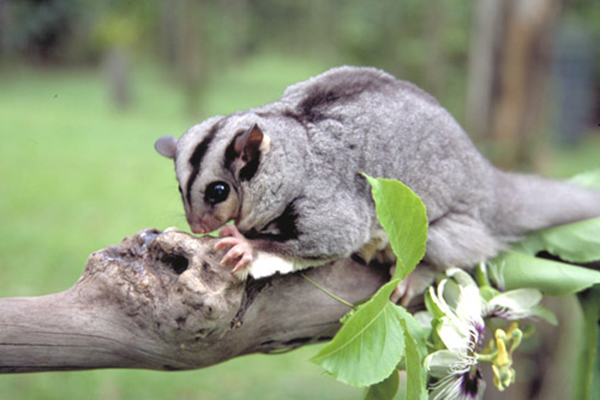 Mahogany Glider
Mahogany Glider
Status:
Endangered – Nature Conservation (Animals) Regulation 2020 (Queensland).
Endangered – Environment Protection and Biodiversity Conservation Act 1999 (EPBC Act).
Endangered – IUCN Red List.
Conservation Advice:
There is no approved Conservation Advice for this species.
Recovery Plan:
There is a National Recovery Plan for this species.
Threat Abatement Plan:
There is one Threat Abatement Plan for this species (Feral cats).
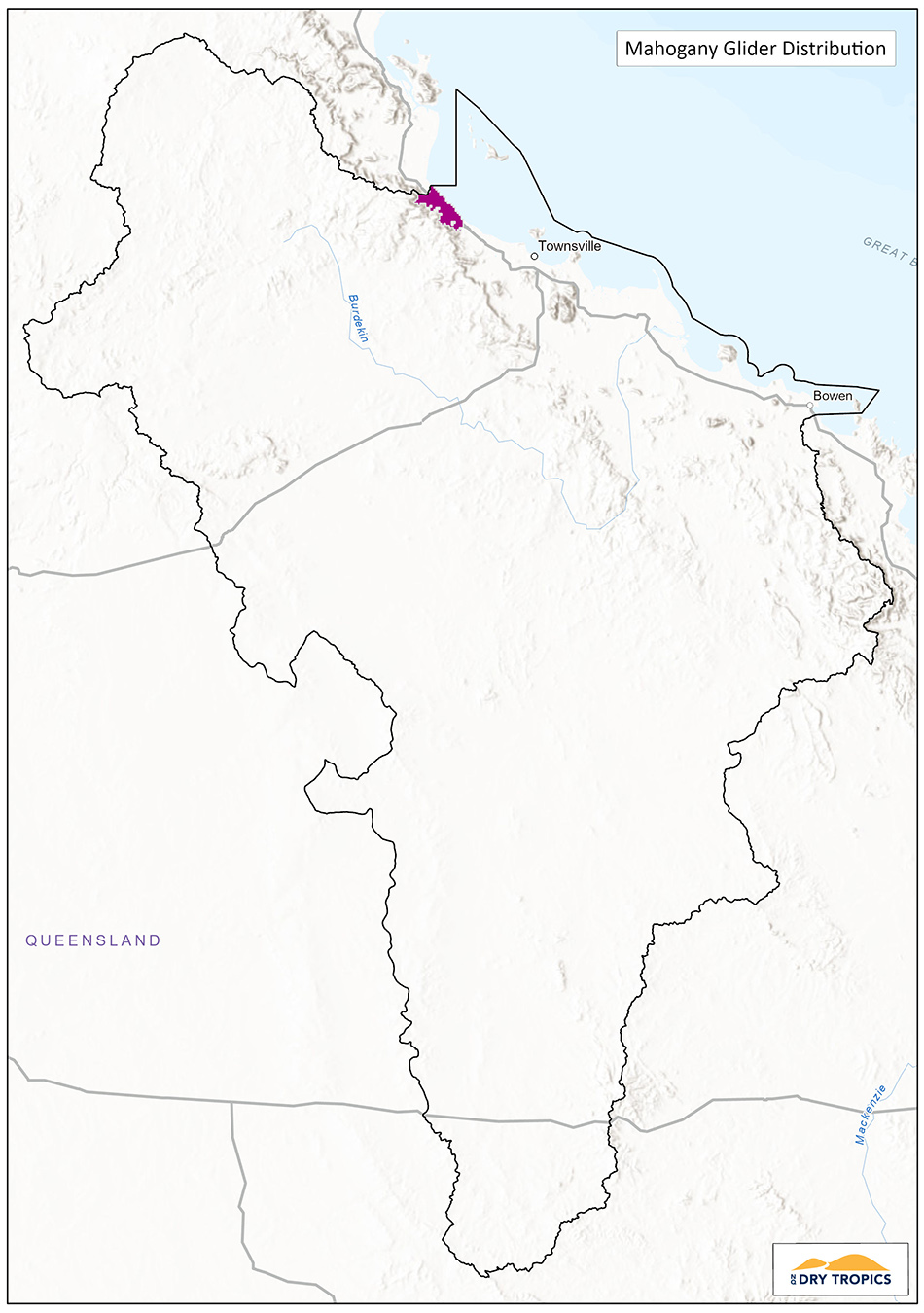 Background Information:
Background Information:
The Mahogany Glider (Petaurus gracilis) is one of six species in the genus Petaurus, or ‘wrist-winged gliders’ that also includes the Sugar Glider, Squirrel Glider and Yellow-bellied Glider.
These arboreal (living in trees) marsupials have specialised fold of loose skin extending between the wrist and ankle on each side, that when extended act as ‘wings’ that enable them to glide for distances over 100m. They use this form of movement to move between trees, thereby avoiding descending to the forest floor. Their diet is made up of nectar, pollen, plant exudate, insects, honeydew and Acacia seed arils.
Mahogany Glider habitat is tropical lowland open eucalypt and melaleuca woodland. They occur only in Queensland and have a very limited range, stretching around 120km along the east coast from Hull River in the north (near Tully) to Ollera Creek in the south (near Ingham) and around 100km inland to the lower Herbert Gorge area and the foothills of the Mt Fox section of Girrungun National Park. In the Burdekin Dry Tropics NRM region, this includes the southern section of Paluma National Park and the Mt Fox section of Girrungun National Park.
The primary threats to the species, identified in the National Threatened Species Recovery Plan are clearing of habitat (primarily for agriculture) and degradation and fragmentation of remaining habitat, due to grazing, fire regimes, weed incursion and road development. Vehicle strikes and entanglement on barbed wire fences have also been recorded.
Management is primarily undertaken by the Department of Environment and Science and Queensland National Parks and Wildlife Service (where populations are within National Park boundaries). The actions required to prevent further losses and increase populations are provided in the National Threatened Species Recovery Plan for the species:
- Update mahogany glider habitat mapping and identify areas for protection, restoration and management.
- Develop strategies to conserve mahogany glider habitat on private lands.
- Identify, manage and monitor habitats threatened by encroaching rainforest.
- Implement habitat recovery burns at key sites and improve weed control.
- Promote a mahogany glider friendly-fencing scheme.
- Reduce threats arising from transport and easement corridors.
- Determine the population genetic structure of mahogany gliders.
- Review the recovery plan.
Key Collaborators
This list does not cover all groups or organisations, but rather represents the ‘key’ organisations and groups whose assistance, advice, approval or cooperation would be required to work on the Mahogany Glider in the Burdekin Dry Tropics region.
- Department of Agriculture, Water and Environment (DAWE)
- Queensland Department of Environment and Science (DES)
- Queensland Parks and Wildlife Service (QPWS)
- Wet Tropics Management Authority (Division of DES)
- Mahogany Glider Recovery Team
- Nywaigi, Warrungnu and Gugu Badhun Traditional Owners and Girringun Reference Group
- Wildlife Preservation Society of Queensland – Glider Network (Conservation Not for Profit group)
- Terrain NRM (regional NRM group)
- NQ Dry Tropics (regional NRM group)
Monitoring:
Populations within National Parks are monitored by the Queensland National Parks and Wildlife Service (QPWS), companies such as Powerlink Queensland Pty Ltd that undertake work in Mahogany Glider habitat also undertake monitoring as part of their activities. The Queensland Glider Network has also undertaken monitoring activities – https://wildlife.org.au/queensland-glider-network/.
Other monitoring programs and sources of data are available through the below links:
- Atlas of Living Australia – https://bie.ala.org.au/species/urn:lsid:biodiversity.org.au:afd.taxon:f95f93b4-3038-41d1-97b9-caf80eec87be
Potential indicators for mahogany gliders include:
- Presence and abundance
- Availability and use of suitable habitat
- Rates and causes of mortality
- Fecundity
Links and further information:
- Burdekin Dry Tropics Conservation Action Plan Summary Report
- Department of Environment and Science –https://www.environment.gov.au/biodiversity/threatened/species/20-mammals-by-2020/mahogany-glider
- Species Profile and Threats Database (SPRAT) – https://www.environment.gov.au/cgi-bin/sprat/public/publicspecies.pl?taxon_id=26775
- National Threatened Species Recovery Plan – Mahogany Glider – https://www.environment.gov.au/biodiversity/threatened/recovery-plans/recovery-plan-mahogany-glider-petaurus-gracilis
- Wildlife Preservation Society of Queensland – Glider Network – https://wildlife.org.au/queensland-glider-network/
- IUCN Red List profile – https://www.iucnredlist.org/species/16727/21959531#conservation-actions
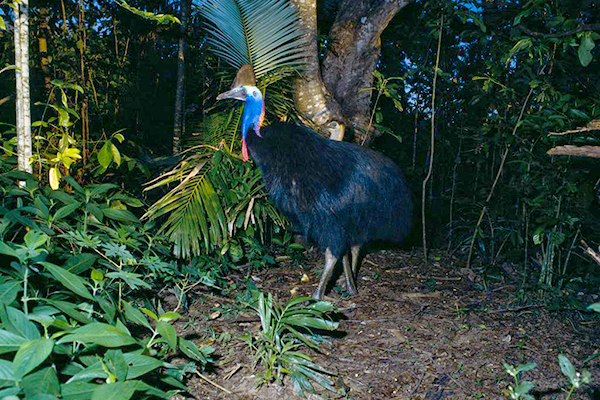 Southern Cassowary
Southern Cassowary
Status:
Endangered – Nature Conservation (Animals) Regulation 2020 (Queensland).
Endangered – Environment Protection and Biodiversity Conservation Act 1999 (EPBC Act).
Least Concern – IUCN Red List.
Conservation Advice:
There is no approved Conservation Advice for this species.
Recovery Plan:
There is a National Recovery Plan for this species.
Threat Abatement Plan:
There is one Threat Abatement Plan for this species (Feral pigs).
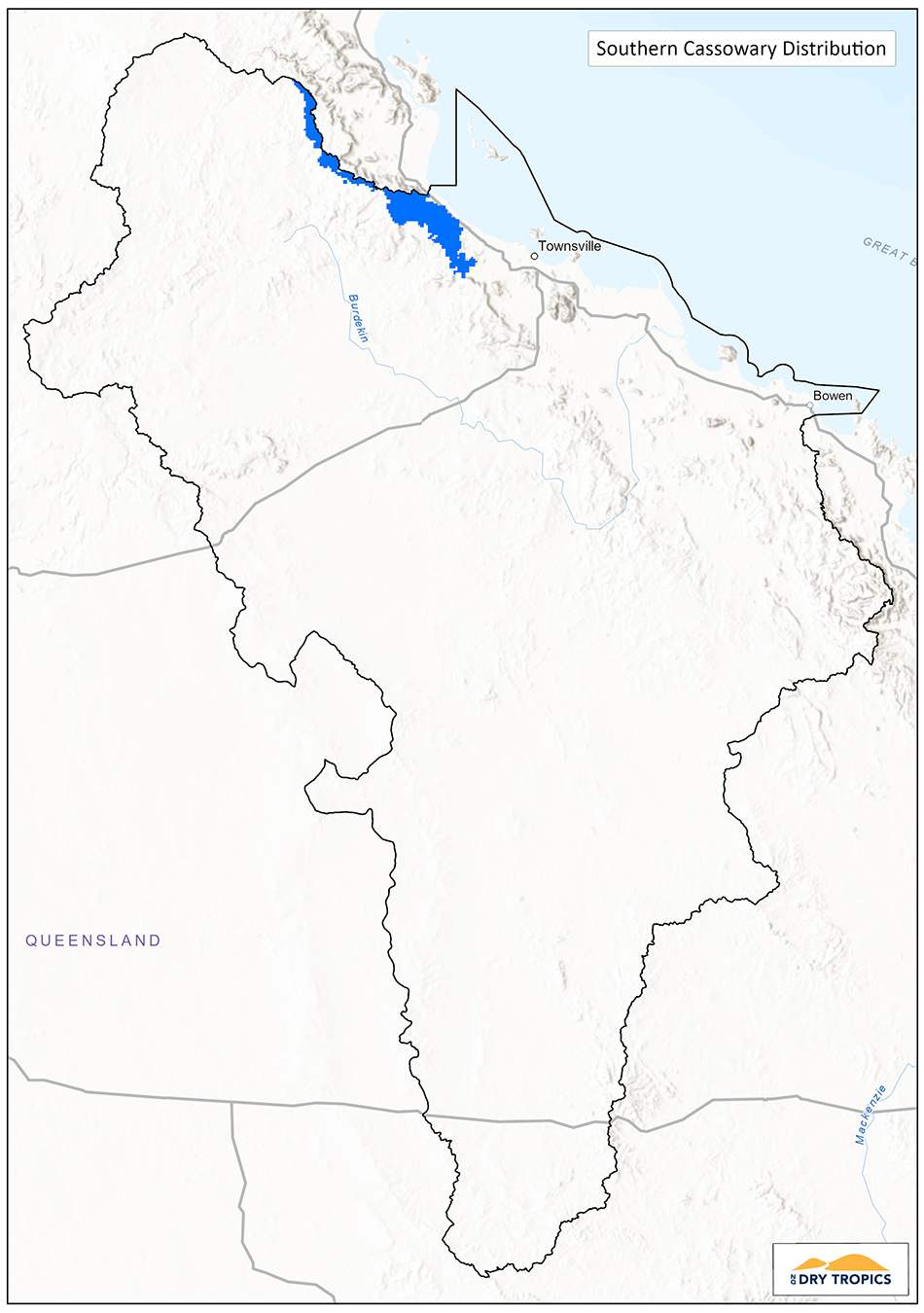 Background Information:
Background Information:
The Southern Cassowary (Casuarius casuarius johnsonii) is a large, flightless bird that is one of three cassowary species. It is the only cassowary species that is found in Australia, with the other species found in Papua New Guinea.
Southern Cassowaries are found only in the Wet Tropics, primarily in rainforest (although they may use associated areas, such as woodland). The bulk of the diet is comprised of fleshy fruits that are foraged from the forest floor or directly from the plant. They will also eat small vertebrates, invertebrates, fungi, plants and carrion.
The distribution of the Southern Cassowary stretches from Cooktown in the north, to Paluma in the south. Core habitat is coastal lowlands between Ingham and Mossman, and uplands in the southern Atherton Tablelands and other ranges, as well as areas of Cape York. In the Burdekin Dry Tropics region, the range of the Southern Cassowary extends into the most southern area of Paluma National Park.
Management of the Southern Cassowary within National Parks is primarily managed by the Queensland National Parks and Wildlife Service. Outside of park boundaries, management is undertaken through a coordinated effort between local, state and national government, community groups and other organisations, such as regional NRM groups.
There are eight main threats to the Southern Cassowary as laid out in the National Threatened Species Recovery Plan:
- Habitat loss from clearing: more than 80 per cent of coastal lowland habitat has gone.
- Habitat fragmentation: much of remaining habitat is fragmented, isolating groups and disrupting movement.
- Habitat degradation: through invasion of weeds such as pond apple, and changed fire regimes.
- Roads and traffic: cassowaries are killed by vehicles on roads.
- Dog attacks: urban development brings more domestic dogs.
- Hand feeding: brings cassowaries closer to vehicle traffic and dogs.
- Diseases: aspergillosis, avian tuberculosis and parasites.
- Natural catastrophic events: cyclones.
The overall objective of the species recovery plan is to protect cassowaries, habitats and corridors from threats through better planning, monitoring and community involvement.
The following recovery actions are specified in the species recovery plan:
- complete the mapping of essential cassowary habitat and identify areas and corridors to protect, restore and manage;
- develop and implement Cassowary Conservation Local Area Plans as part of local planning;
- minimise cassowary road deaths and dog attacks, and assess impact of pigs;
- implement a translocation plan as part of rescue, rehabilitation and release;
- establish a monitoring program in key habitats;
- develop and implement a population survey methodology based on faecal DNA;
- study cassowary population at Mission Beach and determine genetic structure; and
- involve community in cassowary conservation.
Key Collaborators
This list does not cover all groups or organisations, but rather represents the ‘key’ organisations and groups whose assistance, advice, approval or cooperation would be required to work on the Southern Cassowary in the Burdekin Dry Tropics region.
- Department of Agriculture, Water and Environment (DAWE)
- Queensland Department of Environment and Science (DES)
- Queensland Parks and Wildlife Service (QPWS)
- Wet Tropics Management Authority (Division of DES)
- Cassowary Recovery Team
- Nywaigi Traditional Owners and Girringun Reference Group
- Terrain NRM (regional NRM group)
- NQ Dry Tropics (regional NRM group)
Monitoring:
Populations within National Parks are monitored by the Queensland National Parks and Wildlife Service (QPWS) and other organisations, such as Terrain NRM may also undertake monitoring on selected sites.
Other monitoring programs and sources of data are available through the below links:
- Atlas of Living Australia – https://bie.ala.org.au/species/urn:lsid:biodiversity.org.au:afd.taxon:a1408f1a-50e5-4f9c-8cdf-bd6f27a12828
- Southern Cassowary 3 Year Score Card 2018 – https://www.environment.gov.au/system/files/pages/6717d609-c9af-4b89-a044-48968385890d/files/southern-cassowary-year-3-scorecard.pdf
- Westcott, D., Metcalfe, S., Jones, D., Bradford, M., McKeown, A., Ford, A. (2014) Estimation of the population size and distribution of the southern cassowary, Casuarius casuarius, in the Wet Tropics Region of Australia.- http://www.nerptropical.edu.au/publication/project-34-final-report-estimation-population-size-and-distribution-southern-cassowary
Potential indicators for southern cassowaries include:
- Presence and abundance
- Availability and use of suitable habitat
- Rates and causes of mortality
- Fecundity
Links and further information:
- Burdekin Dry Tropics Conservation Action Plan Summary Report
- Department of Environment and Science – https://www.environment.gov.au/biodiversity/threatened/species/20-birds-by-2020/southern-cassowary
- Species Profile and Threats Database (SPRAT) – https://www.environment.gov.au/cgi-bin/sprat/public/publicspecies.pl?taxon_id=25986
- National Threatened Species Recovery Plan – Southern Cassowary – http://www.environment.gov.au/biodiversity/threatened/recovery-plans/recovery-plan-southern-cassowary-casuarius-casuarius-johnsonii
